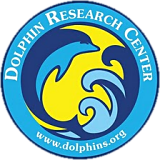Dolphin Research Center
| Dolphin Research Center | |
|---|---|
 | |
 | |
| 24°46′01″N 80°56′44″W / 24.76696°N 80.94552°W | |
| Date opened | 1984 |
| Location | Grassy Key, Florida, United States |
| No. of animals | 27 |
| No. of species | 3 |
| Memberships | AMMPA[1] |
| Major exhibits | Dolphin lagoons, California sea lion lagoon |
| Website | www |
The Dolphin Research Center is a dolphinarium on Grassy Key, Florida. The 90,000-square-foot (8,400 m2) series of saltwater lagoons carved out of the shoreline is home to a family of bottlenose dolphins and California sea lions. It features experiences where visitors can learn about marine mammals and the environment and also swim with, hand-signal, or enjoy other interactive programs with the dolphins.
Overview
It opened in 1958 as Santini's Porpoise School, a roadside attraction owned by Milton Santini, a Corsican commercial fisherman. Some of the early dolphins, including Mitzi, Little Bit and Mr. Gipper, starred in the Flipper movie. The facility became known as Flipper's Sea School after its sale to an entertainment conglomerate in 1972. Five years later, whale conservationist Jean Paul Fortom-Gouin acquired the center, renaming it the Institute for Delphinid Research and closing it to the public.
When the International Whaling Commission imposed a moratorium on whaling in 1983, Fortom-Gouin transferred the business to his general manager and head trainer, Jayne Shannon Rodriguez and Armando "Mandy" Rodriguez. They founded the center as the nonprofit Dolphin Research Center in February, 1984.
In the late 1980s to early 1990s, they featured kids with dolphins that was shot on location there as seen on Sesame Street.
The organization's mission states that through education, research and rescue, Dolphin Research Center promotes peaceful coexistence, cooperation and communication between marine mammals, humans and the environment we share with the well being of DRC's animals taking precedence.
The facility is open daily to the public with informative narrated behavior sessions and educational presentations offered throughout the day. There are also a number of interactive programs available.
Dolphin Camp, Teen DolphinLab classes, and Adult DolphinLab courses offer week-long educational opportunities for various age groups. All of the Adult courses are college-accredited. There are also a variety of other one-day and overnight educational programs available for school and youth groups such as Dolphin Day Trips, Dolphin Discovery and Dolphins: Dusk to Dawn. In recent years, the center also established Distance Learning programs. All of the center's educational programs are designed to meet national and Florida Next Generation standards and Common Core.
The center's research activities are ongoing and largely focus on marine mammal cognition, behavior and husbandry. In 2005, research on Understanding of the Concept of Numerically 'Less' in Bottlenose Dolphins was published by the Journal of Comparative Psychology. In 2009, Animal Cognition published the study on What do Dolphins Understand about Hidden Objects? In 2010, the International Journal of Comparative Psychology published Dolphin Research Center's study on Blindfolded Imitation in Bottlenose Dolphins (Tursiops truncatus). In 2013, Animal Cognition published the follow up study Switching Strategies: A Dolphin’s Use of Passive and Active Acoustics to Imitate Motor Actions. The facility has been featured in numerous television programs worldwide.
Most of the resident pod members were born at the facility. Others joined the family for a variety of reasons.
Dolphin Research Center received an addition to their family in January 2008. Jax, the young bottlenose dolphin, was a victim of a shark attack and was found in the St. John's River off of Jacksonville, Florida. Jax was rehabilitated at Gulf World Marine Park before moving to the Dolphin Research Center permanently. In September 2010 a young dolphin was found in Louisiana, covered in oil. After successfully recovering from all of his injuries, Louie was deemed non releasable by the U.S. government. He was brought to DRC in February 2011, named Louie from the location he came from.
In 2012, Dolphin Research Center established the College of Marine Mammal Professions in response to the limited availability of licensed professional educational programs that prepare individuals for careers regarding the behavior, care and training of marine mammals. The CMMP offers an Associate of Science Degree in Marine Mammal Behavior, Care and Training,[2]
Notes
- ^ "Our Members". ammpa.org. AMMPA. Retrieved June 30, 2012.
- ^ http://www.dolphins.org/visit_cmmp.php
